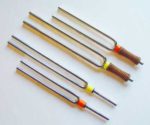Teaching Video NeuroImages: Use your tuning fork to diagnose vertigo
Michael Strupp, Andreas Zwergal
First published October 7, 2019,
A 47-year-old patient reported, “I have been able to hear my eye movements in my left ear for 3 years. When I sneeze I get a short attack of vertigo.” When vibration sense was tested by tuning fork (placing it on the sternum and medial malleolus), the patient heard the sound in his left ear indicative of autophony, typical for superior canal dehiscence syndrome. Diagnosis was proven by fistula tests, vestibular evoked myogenic potentials,1 and CT scan2 (supplementary material). Testing vibration sense can contribute to the diagnosis of vertigo and detection of the affected ear.
References
1.Fife TD, Colebatch JG, Kerber KA, et al. Practice guideline: cervical and ocular vestibular evoked myogenic potential testing: report of the Guideline Development, Dissemination, and Implementation Subcommittee of the American Academy of Neurology. Neurology 2017;89:2288–2296.Abstract/FREE Full TextGoogle Scholar
2.Ward BK, Carey JP, Minor LB. Superior canal dehiscence syndrome: lessons from the first 20 years. Front Neurol 2017;8:177.CrossRefPubMedGoogle Scholar

